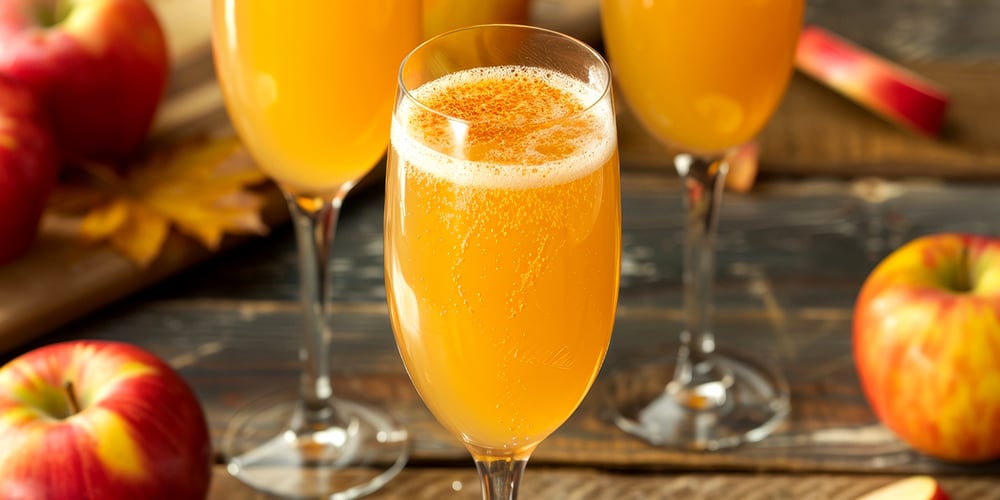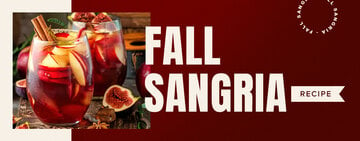If you're looking for a fall beverage option that's easy to make and requires minimal ingredients, try our apple cider mimosa. This union of sweet apple cider and bubbly prosecco is a winning combination that appeals to a wide range of tastes. Whether you're hosting a holiday brunch, a fall-themed event, or simply looking to offer something unique to your customers, this apple cider mimosa is a crowd-pleaser.
Apple Cider Mimosa Recipe
Trade the orange juice for fresh apple cider and whip up this straightforward cocktail. We've used a glass rimmer to add an indulgent caramel rim to the glass for extra sweetness.
Yield: 1 serving
Total Time: 5 minutes
Ingredients

- Caramel sauce
- 2 Tablespoons granulated sugar
- 1 teaspoon cinnamon (or apple pie spice)
- 3 ounces apple cider
- 4 ounces chilled prosecco
Directions
- Add caramel sauce to glass rimmer plate.
- Combine sugar and cinnamon and add to second plate.
- Dip rim of glass or flute into caramel sauce.
- Gently dip into spice mixture to coat rim of glass.
- Add 3 ounces apple cider to glass.
- Top off with 4 ounces chilled prosecco.
- Garnish with dried apple slice and serve!
Can I Make This by the Pitcher?
Yes, you can make a batch of apple cider mimosas for large tables or parties. Chill a 60-ounce pitcher beforehand. Add 24 ounces of apple cider to the pitcher. Just before serving, top off the pitcher with 32 ounces of chilled prosecco. This apple cider mimosa pitcher contains 8 servings.
Can I Make an Apple Cider Mimosa Mocktail?
Yes, absolutely! You can turn this drink into a mocktail by substituting a non-alcoholic sparkling wine for the prosecco.

Adding apple cider mimosas to your menu can help attract customers looking for something special and unique to enjoy. This seasonal drink offers a cozy and comforting taste that perfectly complements the cooler weather and holiday season. By offering this festive beverage, you can create a memorable experience for your guests and set your establishment apart from the competition.
Related Resources

Hard Cider Explained
Whether you're looking to build out your beverage selection or want to offer guests a gluten-free alternative to beer, hard cider is an excellent addition to your menu. Hard cider features a sweeter, brighter flavor profile than beer styles and is especially popular during the fall. We'll introduce what hard cider is, how you can make it, and the different types of cider to choose from below. Click below to skip ahead to a specific hard cider topic: What Is Hard Apple Cider? How to Make Hard Cider Best Yeast for Cider Best Hard Cider Hard Cider FAQ What Is Hard Cider? Hard cider, sometimes called hard apple cider or just cider, is an alcoholic drink made from fermented apple juice. Though you can make hard cider from all kinds of apples, cider apples are recognized as the best choice. It is most popular during the late summer and fall months. Hard cider has a rich history and cultural significance in many countries including Europe and America. It has been enjoyed for centuries and is deeply ingrained in the traditions of countries like England, France, and Spain. The production methods and flavor profiles can vary greatly depending on the region, resulting in a wide range of cider styles to explore. Is Hard Cider Alcoholic? Hard cider is an alcoholic drink, but its alcohol content can vary depending on the type of cider you choose, the production process, and the brand. Hard Cider Alcohol Content On average, most hard ciders are 4.5% - 7% alcohol by volume (ABV), while some ciders have an ABV as high as 10% or 12%. Drier ciders usually have a higher ABV because the yeast consumes a majority of the cider's natural sugars. Types of Hard Cider There are three main types of hard cider, each appealing to individuals with different palettes. The key distinction between them is their level of sweetness, and most can be purchased still or carbonated. We've outlined the most popular types of hard cider below: Dry Cider: These types of cider are typically the most acidic and contain less than 0.5% residual sugar. This less-sweet drink also contains a higher alcohol content than other ciders. Most dry ciders are aged in oak barrels to complement their mineral qualities. Off-Dry Cider: These ciders have a smooth texture and a rich, sweet flavor. They have slightly more body than other types of cider and typically contain 1% - 2% residual sugar. Semi-dry and Semi-sweet Cider: These two ciders are classified together because they share many characteristics. They feature pronounced apple flavors and have heartier bodies than their counterparts. Semi-dry ciders contain above 2% residual sugar, while semi-sweet ciders can carry as much as 4%. How to Make Hard Cider If you have a liquor license, making hard cider is a great way to expand your seasonal drink menu. We've included a list of instructions to walk you through the process of making hard cider below: What Special Equipment Do I Need? Fermentation containers Rubber stopper Air lock Bottles and caps Hard Cider Recipe Yield: 21 servings Hard Cider Ingredients 2 gallons fresh-pressed apple juice 1/2 packet yeast (Optional) Sugar Directions Fill fermenting bucket or glass jug with apple juice. Add yeast to juice to begin fermentation process. Seal container using rubber stopper and airlock. Allow mixture to ferment. This can take up to two weeks depending on your desired dryness. Let mixture sit for up to a week, letting yeast settle. Rack cider into a sanitized vessel with no headspace. (Optional) Add gelatin or pectic enzyme to bind and break down undesired proteins. (Optional) Add sugar to increase sweetness. Disperse cider into bottles. Best Yeast for Cider White wine yeast and champagne yeast are the two most popular options for making hard cider. Yeast is a microorganism that plays a vital role in fermentation, converting the sugars present in the liquid into alcohol. The type of yeast you use can impact the flavor, aroma, and overall quality of your cider. White Wine Yeast: This type of yeast is a versatile option that can enhance the fruity flavors in your cider. It is also known for its ability to ferment at cooler temperatures. Champagne Yeast: This type of yeast can tolerate high alcohol levels. It is often used in sparkling wines and can give your cider a crisp and effervescent quality. Best Hard Cider There are many hard ciders to try, and we'll take you through some fan-favorite hard cider brands below: Stella Artois Cidre (Baldwinsville, New York) 4.5% ABV Blake's Hard Cider Co. Triple Jam (Armada, MI) 6.5% ABV Magners Irish Pear Cider (Clonmel, IE) 4.5% ABV Woodchuck Amber Hard Cider (Middlebury, VT) 5% ABV ACE Apple Cider (Sonoma County, CA) 5% ABV Samuel Smith's Organic Cider (Yorkshire, ENG) 5% ABV Best Hard Cider for Fall If you're looking for some excellent beverages to try during fall, explore these hard ciders: Cigar City Cider and Mead Homemade Apple Pie (Tampa, FL) 5.5% ABV Wyndridge Farm Cranberry Cider (York, PA) 5.5% ABV Harpoon Brewery Pumpkin Cider (Boston, MA) 4.8% ABV Seattle Cider Pumpkin Spice Hard Cider (Seattle, WA) 6.9% ABV Woodchuck Fall Harvest Hard Cider (Middlebury, VT) 5% ABV Strongbow Cider Artisanal Blend (Herefordshire, UK) 6% ABV Hard Cider FAQ If you're new to hard cider, there is much to learn. We'll answer some common questions about the topic below: Is Hard Cider Gluten Free? Most hard ciders are gluten-free. While some yeasts can contain gluten, the yeasts used in the hard cider fermentation process are naturally gluten-free. Be sure to check the ingredients in your hard cider to ensure there are no additives that may contain gluten. Is Hard Cider Beer? Although it can be found on beer lists, hard cider is not considered beer. The only quality the two drinks have in common is that they are fermented beverages. Beer is a fermented alcoholic beverage that's brewed from malt and flavored with hops, while cider is an alcoholic drink made from fermented fruit juice, typically from apples. The fact that cider contains no malt or hops makes these two beverages unique. It's important to note that hopped ciders are becoming trendy in bars and on beer lists. These ciders contain hop flavors and aromas usually found in beer but are still not brewed with malt, making them a gluten-free beer substitute. Like hard seltzer, hard ciders provide a lighter alternative to beer on a bar menu. How to Store Hard Cider Since hard cider is fermented, it doesn't have to be refrigerated once it is bottled or canned. However, there are a few guidelines to ensure that your hard cider stays fresh and delicious. The ideal storage temperature for hard cider is between 40 and 60 degrees Fahrenheit. If you have a cellar or a cool basement, these are great places to store your cider. The consistent temperature and darkness will help maintain the flavor profile. Hard cider cans should be stored upright or on their sides. This helps distribute the yeast evenly throughout the cider, ensuring a consistent flavor. Never let your hard cider freeze, as this can kill yeast and alter the flavor of your cider. Back to Top Hard cider is an increasingly popular alcoholic beverage and an excellent alternative to beer or for those following a gluten-free diet. Enjoy this drink year-round as a seasonal fall or winter alcoholic choice or as a cool refresher in the spring and summertime.

How to Make a Fall Sangria
If you're looking for something more complex and warming than apple cider, but more imaginative than a classic Thanksgiving wine pairing menu, our fall sangria recipe is for you. Effervescent sparkling cider and rich red wine lay the foundation, juicy fig puree adds lusciousness, vibrant apple and orange slices add freshness, and baking spices leave an aromatic finish. Whether you're creating a fall drink special or catering alcohol at a fall event, our quick and easy fall sangria recipe is the perfect seasonal autumn drink. Fall Sangria Recipe Made in a batch and sure to please a crowd, this Thanksgiving sangria recipe is loaded with fall flavors. It includes enough classic elements to be approachable and enough unexpected elements to stand out. Approximate Yield: 6-8 servings Total Time: 10 minutes Ingredients 1 bottle light red (we used pinot noir, but select the type of wine you prefer) 4 ounces orange liqueur (we used Cointreau) 16 ounces sparkling cider 4 ounces of fig puree 1/2 cup apple slices (1 apple sliced) 1 orange sliced 2 cinnamon sticks 1/8 teaspoon ground ginger Optional: dried fig for garnish Directions Cut apple and orange into slices. Add to pitcher. Pour red wine into pitcher. Measure and pour orange liqueur into pitcher. Add fig puree, cinnamon sticks, and ground ginger to pitcher, then stir. For stronger fruit flavor, chill pitcher in fridge overnight. When ready to serve, add sparkling cider. Garnish with skewered dried fig. Please note: Whether you're serving this sangria by the glass or by the pitcher, don't add the sparkling apple cider until just before you are ready to serve. If you add it too soon, the sangria will lose the bubbles and go flat. Not just for charcuterie boards, figs are a beloved early fall fruit that adds a jammy, honeyed berry flavor to our fall sangria recipe. You can serve it by the pitcher, as part of your holiday takeout packages, or by the glass. This unexpected Thanksgiving sangria pairs perfectly with alternative Thanksgiving meals that play into flavors of the season but suit guests with alternative diets or those seeking unique takes on holiday classics.

Mimosa Recipes
Mother's Day offers a significant opportunity for restaurants to profit. According to the National Restaurant Association (NRA), Mother's Day has remained the most popular day for dining out over the past two decades. For brunch diners seeking something special, mimosas are a delicious and easy cocktail to accompany your Mother’s Day brunch menu. We picked out five recipes for mimosas popular with crowds to help you bring in more revenue on your busiest day of the year and answer some common questions about mimosas to ensure everything runs smoothly. Shop All Champagne Glasses How to Make a Mimosa Our tutorial video teaches you how to make mimosas in classic and unique styles. We also provide detailed mimosa recipes so you can secure the ingredients you need or make cocktail ingredients. <iframe width="560" height="315" src="https://www.youtube.com/embed/v6DYVkzDPKw?rel=0" frameborder="0" allowfullscreen></iframe> Types of Mimosas From classic orange juice mimosas to tropical fruit juice mimosas, discover the most popular types of mimosas. We provide recipes for each type of mimosa so you can add them to your Mother's Day drink menu. 1. Orange Juice Mimosa An orange juice mimosa is a classic take on this popular drink. Freshly squeezed orange juice enhances the flavor of the cocktail, but storebought orange juice works too. Yield: 6 - 8 mimosas Orange Juice Mimosa Ingredients 3 cups orange juice, freshly squeezed 1 bottle dry champagne Triple sec (to taste) Orange twists for garnish Directions Fill half of champagne glass with orange juice. Top off glass with champagne. Add dash of triple sec. Garnish with orange twist. 2. Blushing Mimosa For a flavorful twist on the classic mimosa, a blushing mimosa includes pineapple and grenadine to embellish this cocktail. Blushing mimosas get their name from their light pink-orange hue, resembling blushing cheeks. Yield: 6 - 8 mimosas Blushing Mimosa Ingredients 2 cups orange juice, freshly squeezed 1 cup pineapple juice 2 Tablespoons grenadine 1 bottle champagne or sparkling wine Orange peel for garnish Directions Add 2 cups orange juice to liquid measuring cup. Add 1 cup pineapple juice to same cup. Add 2 Tablespoons grenadine to same cup and stir. Fill half of glass with the juice mixture. Top off glass with champagne. Garnish with orange peel. 3. Strawberry Pineapple Mimosa A strawberry pineapple mimosa offers a tropical flair to this delicious cocktail. In addition to orange juice, add pineapple juice and sliced strawberries to the champagne or sparkling wine. Yield: 6 - 8 mimosas Strawberry Pineapple Mimosa Ingredients 1 1/2 cups orange juice 1 1/2 cups pineapple juice 1 bottle champagne or sparkling white wine Strawberries, sliced, for garnish Directions Add 1 1/2 cups orange juice to liquid measuring cup. Add 1 1/2 cups pineapple juice into same cup and stir. Fill half of glass with juice mixture. Top off glass with champagne. Garnish with strawberry. 4. Peach Bellini Though not technically a mimosa, a peach bellini is a popular, champagne-based cocktail originating in Venice, Italy. It uses Prosecco, a peach puree, and occasionally other fruit for garnish. Yield: 4 - 6 drinks Peach Bellini Ingredients 16 ounce bag frozen peaches 1/2 ounces lemon juice 1/2 cup sugar 1/2 cup water 1 bottle of Prosecco or other sparkling white wine Directions Add 16 ounces of frozen peaches to commercial blender. Add 1/2 ounces of lemon juice to blender with lemon squeezer. Add 1/2 cup of sugar to blender. Puree and use mesh strainer to remove peach chunks over mixing bowl. Fill half of glass with puree. Top off glass with Prosecco. 5. Kir Royale A Kir royale is a French cocktail with a champagne base, much like mimosas. However, it also includes creme de cassis - a sweet, red liqueur made from blackcurrants - rather than fruit juice. Since it isn't present in the drink, fruit acts as a garnish. Yield: 4 - 6 drinks Kir Royale Ingredients 3- 4 Tablespoons creme de cassis 1 bottle champagne or dry sparkling wine Raspberries for garnish Directions Add 1 - 2 teaspoons of creme de cassis to each glass. Top off glass with champagne. Garnish with raspberries. Mimosa Recipe Resizer If you expect a large crowd on Mother's Day, you might need to adjust recipes to accommodate your customers. Use our recipe resizer to adjust our mimosa recipes for your anticipated number of patrons. Remember, it is always safer to have more ingredients than you need than to run out early. How to Make a Mimosa Bar Making a mimosa bar is an excellent option to accommodate customers during their Mother's Day brunch. A mimosa bar relieves your servers and increases customers' perceived value. For more control, dedicate a single staff member to working the mimosa bar and assembling drinks upon request. Use social media to advertise your bottomless mimosa bar and sell tickets to your Mother's Day brunch in advance, locking in a guaranteed set of customers. To get started, here are some simple steps for setting up a mimosa bar. Set up a self-serve station. Place the table with your mimosa bar ingredients in an accessible area so patrons do not feel crowded. Chill your champagne. Use a wine bucket to keep your champagne or sparkling wine cool. Monitor the bucket and ensure there is plenty of ice throughout the event. Replace empty bottles when necessary. Pour the juice into labeled glass carafes. Purchasing uniform, aesthetic carafes for the different types of juice on your mimosa bar creates an attractive presentation. Glass carafes allow the colorful juice to shine. Place champagne glasses on a serving tray, to enhance the visual appeal. Fill small bowls with mimosa garnishes. Place the garnish bowls in front of the juice they complement. Mimosa garnish ideas include fresh herbs, orange slices, berries, pineapple wedges, and pomegranate seeds. Add a serving spoon, fork, or toothpick to each bowl. Prevent contamination with serving utensils. Arrange decorations throughout the table. Flowers are a Mother's Day classic. Mimosa FAQ Before you start serving these delicious mimosas, other details come in handy. Knowing how many mimosas you can make with one bottle of champagne or which ingredients are in mimosas helps with recipe resizing and stocking supplies. Below are several common questions about mimosas to help prepare you for your Mother's Day brunch. What Is in a Mimosa? Mimosas consist of champagne or sparkling wine and fruit juice. Orange juice is the most popular option. The key aspect of mimosas is the fizz from the champagne, so open, store, and pour the champagne correctly to retain this quality. How Many Mimosas per Bottle of Champagne? A standard 750 mL bottle of champagne yields 6 - 8 mimosas. Other champagne-based drinks, like Kir royales, might only get 4 - 6 drinks per champagne bottle. What Is the Best Champagne for Mimosas? Since most fruit juices are sweet, using dry, extra dry, or brut champagne balances the flavors nicely. Avoid using doux or demi-sec champagne since their sweetness paired with the fruit juice will overwhelm the palate. Mimosa Garnish Ideas Try garnishing your mimosas with fresh herbs, orange slices, berries, pineapple wedges, pomegranate seeds, or dried fruit. Create a memorable Mother's Day brunch by adding one of these mimosa recipes to your Mother's Day drink menu. Better yet, offer a mimosa bar for more customer appeal. These cocktails are delicious, refreshing, and sure to hit the spot on mom's special day, allowing your establishment to become a yearly tradition for families.





